The LM335 temperature sensor is an analog device which requires an ADC module to convert the analog data which is the voltage output from the LM335 into digital data. The LM335 has the following features:
- Directly Calibrated to the Kelvin Temperature Scale
- 1°C Initial Accuracy Available
- Operates from 400 μA to 5 mA
- Less than 1-Ω Dynamic Impedance
- Easily Calibrated
- Wide Operating Temperature Range
- 200°C Overrange
- Low Cost
This topic shows how to interface the LM335 temperature sensor with PIC16F877A microcontroller.
Hardware Required:
- PIC16F877A microcontroller
- LM335 Temperature sensor - datasheet
- 16x2 LCD Screen
- 8MHz crystal
- 2 x 22pF ceramic capacitor
- 10K ohm potentiometer or variable resistor
- 2.2K ohm resistor
- +5V Power supply source
- Breadboard
- Jumper wires
The LM335 sensor has 3 pins (from left to right):
Pin 1 for calibration, not used in this example
Pin 2: output
Pin 3: GND (ground).
The output pin of the LM335 sensor is connected to analog channel 0 (AN0). I chose the 2.2K ohm because as written in the datasheet for optimum accuracy the current flows through the LM335 should be 1mA. For example if the temperature = 27°C, the output will be 3.00V and assume the supply voltage is exactly 5.00V that means the current flows through the sensor is ( 5 - 3)/2.2 = 0.90mA which is good enough. Also the value 2.2K is a standard value and well used.
The 1602 (16x2) LCD screen is connected to pins RD0~6. The 10K variable resistor is used to adjust the brightness of the screen.
In this example the PIC16F877A runs with 8MHz crystal oscillator.
Interfacing PIC16F877A with LM335 sensor CCS C Code:
The following C code was tested with CCS PIC C compiler version 5.051.
/* Interfacing PIC16F877A with LM335 analog temperature sensor CCS C code. Read LM335 datasheet to understand the code! http://ccspicc.blogspot.com/ electronnote@gmail.com */ //LCD module connections #define LCD_RS_PIN PIN_D0 #define LCD_RW_PIN PIN_D1 #define LCD_ENABLE_PIN PIN_D2 #define LCD_DATA4 PIN_D3 #define LCD_DATA5 PIN_D4 #define LCD_DATA6 PIN_D5 #define LCD_DATA7 PIN_D6 //End LCD module connections #include <16F877A.h> #fuses HS,NOWDT,NOPROTECT,NOLVP #device ADC=10 #use delay(clock = 8MHz) #include <lcd.c> char message1[] = "Temp = 00.0 C"; char message2[] = "= 00.0 K"; signed int16 Kelvin, Celsius; void main(){ setup_adc(ADC_CLOCK_INTERNAL); // ADC Module uses its internal oscillator setup_adc_ports(AN0); // Configure AN0 pin as analog set_adc_channel(0); // Select channel 0 (AN0) lcd_init(); // Initialize LCD module lcd_putc('\f'); // Clear LCD while(TRUE){ delay_ms(1000); Kelvin = read_adc() * 0.489; // Read analog voltage and convert it to Kelvin (0.489 = 500/1023) Celsius = Kelvin - 273; // Convert Kelvin to degree Celsius if(Celsius < 0){ Celsius = abs(Celsius); // Absolute value message1[7] = '-'; // Put minus '-' sign } else message1[7] = ' '; // Put space ' ' if (Celsius > 99) message1[7] = 1 + 48; // Put 1 (of hundred) message1[8] = (Celsius / 10) % 10 + 48; message1[9] = Celsius % 10 + 48; message1[12] = 223; // Degree symbol message2[2] = (Kelvin / 100) % 10 + 48; message2[3] = (Kelvin / 10) % 10 + 48; message2[4] = Kelvin % 10 + 48; lcd_gotoxy(1, 1); // Go to column 1 row 1 printf(lcd_putc, message1); // Display message1 lcd_gotoxy(6, 2); // Go to column 6 row 2 printf(lcd_putc, message2); // Display message2 } }Interfacing PIC16F877A with LM335 sensor videos:
The following video shows a breadboard hardware circuit of the example.

